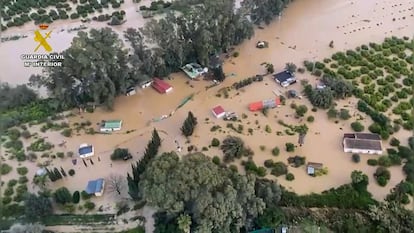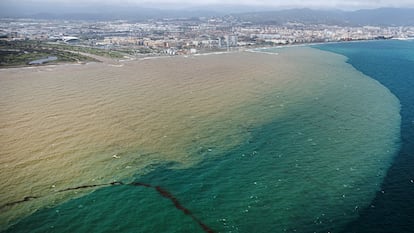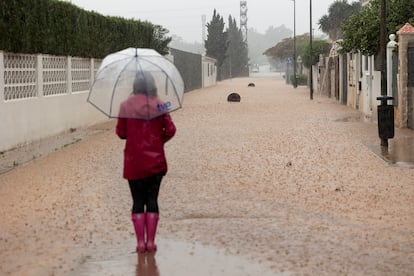Three weeks of unpublished rain in Malaga | Spain

When the actor Miguel Ángel Martín opened the windows of his floor in the early hours of Friday. « It seemed like a verbena, » he explained. The balconies of their street showed an unusual color, but instead of banners or lantern were sheets, sweatshirts, t -shirts or underwear. « A little sun and everyone to put washing machines, » he said as the star began, again, to hide between the clouds. No one in Malaga has known how to organize In the last three weekswith so much water that in the capital they already live the second most rainy since the records of the State Meteorology Agency (Aemet) in 1942 began in 1942. They also accumulate 17 days of rain, when the historical average in this month is just four. Official data also underlines that since February 28 it has rained, even little, Every day in some corner from the Andalusian province. Daily life is chaos in a territory accustomed to dry land. And everything has become even more complicated with the flood of the rivers, which have caused the third large floods since the past fall. The Costa del Sol is these days the coast of the rain.
The Spain that only saw rain in the news now does not know what to do before the succession of the storms. Jana, Konrad, Laurence and Martinho They have erased the sun from time maps. And neither the infrastructure, nor public services, nor houses, nor families are prepared. Until a few weeks ago there was only talk of the lack of water at the drought, but in recent days the conversation revolves around when it will stop raining. An immersive experience in the northern weather that is giving with mood and has caused almost 800 incidents, most public roads, detachments and road damage. In return, the field breathes calmer. Logical, because the change is radical. In these last three weeks the swamps have almost doubled their reservations. They have gone from 171 cubic hectometers at the end of February to 332 (and up) this weekend. Now they exceed 54% of their capacity, just the triple that last year at this point, when restrictions and water cuts were everyday in twenty municipalities. The reserves « give hope to resurface » the mango and avocado sector, as Álvaro Palacios, president of the Spanish Tropical Association, says.

With his usual humor, Martín uploaded a video to social networks at the beginning of the month when the Borrascas train started. « Of course it can rain, but you can spread through the months, right? » Followers of areas like Galicia warned that it was not so much. « But I am not a Galician. I would like A film festival with the soaked red carpet. « This is not ours. It is lazy to get wet, it gives you downturn and the plans are canceled, » added another Malaga, Loli Rodríguez, 40. Cancellations knows Enrique Murillo, 28 years old and responsible for the Las Palmeras restaurant, at the beach. Every time the drops appear on the weekend their beach bar loses a twenty reservations and the billing low in half. « Luckily people are already getting used to and starts out, » says the businessman, relieved by the forecasts that the sun shines again.
Touring the province offers these days a strange image. Green predominates in the landscape and any land shows cracks through which the water runs. It is as if it sprout from a traditionally dry soil. But there is no magic, it has not stopped raining. A review of the 38 rainfall of the Hidrosur Network, of the Junta de Andalucía, indicates that in what we have had of the hydrological year – he argued in October – 33 of them have collected more rainfall than the average. And in some cases the figures of the previous season multiply by four or five. In addition, those located in Ronda, Los Reales, Majada de las Lomas, Pujerra and the Genal River have made full: 22 days of rains in a row since February 28. The figures are very similar in other parts of the Malaga geography. In Benamargosa, already in the axarchy and where there were serious damage in November, there have only been two dry days throughout the month. In the capital it has rained 17 days (four times more than average) to touch its historical record, of 19 days (2018). The 225 liters registered at the airport make this March the second rainiest since 1942 in the capital, when the records began, only surpassed by that of 2004, according to Jesús Riesco, head of Aemet in Malaga. « At this time of the year we are above normal values throughout the province, » he emphasizes.

It rains throughout Spain, but Malaga is the epicenter of the March storm. « He lives an exceptional situation because he has lasted a lot: the usual are strong rains in a short time and now they have been the other way around, but in a long period, » insists the meteorologist Roberto Granda. Of course, there are torrential episodes such as the one that served to accumulate 161 liters per square meter in just 24 hours in Ardales on March 3. The record of the showers has made the Guadalhorce river mark its maximum medium level since there are records, flooding a good part of its riverbank in the municipalities of Álora, Cártama and Málaga. One of the most affected areas is the Doña Ana neighborhood, a handful of houses where floods are almost part of its day to day. This week the water climbed one meter through its streets. « We already had prepared Achique bombs, » says Encarna Pacheco, 68. « We already know what needs to be done; it is repeated a lot, » said Miguel Santos, 62.

Worst passed by the 400 families that had an eviction order before the flood of the Campanillas river due to the rain and water that poured the house of Casasola, which reached 105% of its capacity and had to relieve by its upper edge, since the drain underground is stuck. They also had to leave their houses for a few hundred neighbors of Almogía, Álora and Marbella. Meanwhile, the Civil Guard continues The search for a 61 -year -old motorist which was dragged by a stream in the municipality of Pujerra, in the Serranía de Ronda.








